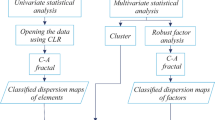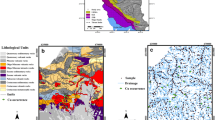Abstract
The purpose of the study was to identify the hypogene mineralization zone in the south of Sungun and Kighal porphyry Cu deposits, based on subsurface data and by using the proposed concentration–array (C–A) multivariate fractal and zonality modeling. The area (Kighal and south of the Sungun mine) is located in northwestern part of the Arasbaran Magmatic Zone (AMZ). AMZ is the host of large porphyry copper and gold epithermal deposits in the northwest of Iran. A litho-geochemical survey used to extract new anomalies. And also, the research has discussed statistics, principal component analysis (PCA) and hierarchical cluster analysis, estimation maps, and multi-element associations in the prospect area. The C-A multivariate fractal and zonality modeling was used for map classification and finally draw promised areas for the litho-geochemical survey in the Kighal prospect. According to multivariate PCA analysis, three groups are determined: the first group is positively correlated with component 2 and reflects the association between Cu and Mo elements that are similar to porphyry copper deposits associated elements and can be a good indicator for porphyry copper mineralization. Investigation of lithogeochemical data and separation of anomalies by C-A multivariate fractal and zonality modeling in south of the Sungun mine and Kighal porphyry prospect revealed that this method has high efficiency in separating anomalies and determining the position of mineralization. Geochemical studies and the field-based obtained data showed that the mineralization and alteration are limited to monzonitic rocks and are located in the southern and eastern parts of the study area, which are in line with the phyllic and mostly potassic alterations.


modified from Aghanabati, 1991, 1998; Hassanpour, 2010; Hassanpour et al., 2015;). b Simplified geology Map of the Kighal area (lower after NICICO, 2007). Abbreviation: UDMB Urmieh-Dokhtar Magmatic Belt, Ean Eocene andesite, Er Eocene rhyolite, Et2 Eocene tuffs, Oan Oligocene andesite, Oda Oligocene dacite, Or Oligocene rhyolite, Otc Oligocene trachye PLQc Pliocen conglomerate, PLQv Pliocene volcanoclastics, Qb Quaternary basalts, Qp Quaternary porphyrite, Qqan Quaternary andesite, Qv Quaternary volcanoclastics, dq: Quartz diorite, gd granodiorite, mz monzonite












Similar content being viewed by others
References
Aghanabati A (1991) Magmatic rocks of Iran, 1: 2,500,000 survey sheet. Geological Survey of Iran (a Persian report)
Alavi M (1991) Tectonic Map of the Middle East, 1: 5000000. Geological Survey of Iran (a Persian report)
Aliyari F, Afzal P, Lotfi M, Shokri S, Feizi H (2020) Delineation of geochemical haloes using the developed zonality index using multivariate and fractal analysis in the Cu-Mo porphyry deposits. Appl Geochem 121:104694
Berberian M, King GCP (1981) Towards a paleogeography and tectonic evolution of Iran. Can J Earth Sci 18:210–265
Beus AA, Grigorian SV (1977) Geochemical exploration methods for mineral deposits. Applied Publishing Ltd, Wilmette, IL, p 287
Carranza EJM (2004) Usefulness of stream order to detect stream sediment geochemical anomalies. Geochemistry: Exploration. Environ Anal 4:341–352
Carranza EJM (2008) Geochemical anomaly and mineral prospectively map** in GIS. Handbook Explor Environ Geochem 11:351
Carranza EJM (2009a) Controls on mineral deposit occurrence inferred from analysis of their spatial pattern and spatial association with geological features. Ore Geol Rev 35:383–400
Carranza EJM, Sadeghi M (2010) Predictive map** of prospectively and quantitative estimation of undiscovered VMS deposits in Skellefte district (Sweden). Ore Geol Rev 38:219–241
Carranza EJM (2009b) Geochemical anomaly and mineral prospectivity map** in GIS. (M. Hale, Edition.). Amsterdam, Netherlands, Elsevier. 347 pages
Cheng Q (1999) Spatial and scaling modelling for geochemical anomaly separation. J Geochem Explor 65(3):175–194
Cheng Q, Agterberg F (2009) Singularity analysis of ore-mineral and toxic trace elements in stream sediments. Comput Geosci 35(2):234–244
Cheng Q, Agterberg FP, Ballantyne SB (1994) The separation of geochemical anomalies from the background by fractal methods. J Geochem Explor 51:109–130
DaneshvarSaein L (2017) Delineation of enriched zones of Mo, Cu and Re by concentration-volume fractal model in Nowchun Mo-Cu porphyry deposit, SE Iran. Iranian J Earth Sci 9:64–72
Dilles JH (2010) Footprints of porphyry Cu deposits, vectors to the hydrothermal center using mineral map** and lithogeochemistry for USGS MRERP grant award number G10AP00052, 580 pp
Farahmandfar Z, Jafari MR, Afzal P, Ashja AA (2020) Description of gold and copper anomalies using fractal and stepwise factor analysis according to stream sediments in NW Iran. Geopersia 10(1):135–148. https://doi.org/10.22059/geope.2019.265535.648413
Gent M, Menendez M, Toraño J, Torno S (2011) A review of indicator minerals and sample processing methods for geochemical exploration. J Geochem Explor 110(2):47–60
Gonçalves MA, Mateus A, Oliveira V (2001) Geochemical Anomaly Separation by multifractal modeling. J Geochem Explor 72:91–114
Grigorian SV (1992) Mining Geochemistry. Nedra Publishing House, Moscow, p 310
Hassanpour S (2010) Metallogeny and mineralization of Cu-Au in Arasbaran Zone, NW of Iran, Unpublished PH.D. Thesis dissertation, Shahid Beheshti University, Iran
Hassanpour S and Rajabpour, S (2019) The Kighal porphyry Cu–Mo deposit. NW Iran: Insights to Fluid Origin Evol Magma Res Russian Geol Geophys 60(10):1141–1162
Hassanpour S, Afzal P (2013) Application of concentration–number (C–N) multifractal modeling for geochemical anomaly separation in Haftcheshmeh porphyry system. NW Iran Arabian J Geosci 3:957–970
Hassanpour S, Alirezaei S, Selby D, Sergeev S (2015) SHRIMP zircon U-Pb and biotite and hornblende Ar-Ar geochronology of Sungun, Haftcheshmeh, Kighal, and Niaz porphyry Cu–Mo systems: evidence for an early Miocene porphyry-style mineralization in northwest Iran. Int J Earth Sci 104:45–59
Imamalipour A, Mousavi R (2017) Vertical geochemical zonation in the Masjed Daghi porphyry copper-gold deposit, northwestern Iran: implications for exploration of blind mineral deposits. Geochemistry: Exploration. Environ Anal 18:120–131
Mandelbrot BB (1983) The Fractal Geometry of Nature. W. H. Freeman, San Fransisco. 468 pp, https://doi.org/10.1002/esp.3290080415
Meigooni sh, Lotfi M, Afzal P, Nezafati N, Kargar Razi M (2021a) Application of multivariate geostatistical simulation and fractal analysis for detection of rare earth elements (REEs) geochemical anomalies in Esfordi phosphate mine, Central Iran. Geochemistry: Exploration, Environment, Analysis21, geochem2020–035, 1–17, https://doi.org/10.1144/geochem2020-035.
Moon CJ (1999) Towards a quantitative model of downstream dilution of point source geochemical anomalies. J Geochem Explor 65:111–132
Nabavi MH (1976) An introduction to the geology of Iran, Geological Survey of Iran, 109 p
Nazarpour A (2018) Application of C-A fractal model and exploratory data analysis (EDA) to delineate geochemical anomalies in the: Takab 1:25,000 geochemical sheet, NW Iran. Iranian J Earth Sci 10:173–180
NICICo (2007) Litho-geochemical explorations in Kighal-Burmolk 1:5000 area
Olivella MÀ, Solé M, Gorchs R, Lao C, De Las Heras FXC (2011) Geochemical characterization of a Spanish leonardite coal. Archive of Mining Sci 56(4):789–880
Shahbazi S, Ghaderi M, Afzal P (2021) Prognosis of gold mineralization phases by multifractal modeling in the Zehabad epithermal deposit, NW Iran. Iranian J Earth Sci 13:31–40
Sim BL, Agterberg FP, Beaudry C (1999) determining the cutoff between background and relative base metal contamination levels use multifractal methods. Comput Geosci 25:1023–1041
Simmonds V, Calagari AA, Kyser k, (2015) Fluid inclusion and stable isotope studies of the Kighal porphyry Cu–Mo prospect. East-Azerbaijan, NW Iran, and Arabian J Geosci 8:437–453
Singer DA (1993) Basic Concepts in three-part quantitative assessments of undiscovered mineral resources. Nonrenew Res 2:69–81
Sohrabi Gh (2015) Study of metallogeny and geochemistry of molybdenum deposits in Gharadagh-Sivardagh belt, East- Azerbaijan, NW Iran. PhD thesis, Tabriz University, Iran, 609p. (in Persian)
Solovov AP (1990) Handbook on geochemical prospecting for useful minerals. Nedra Publishing House, Moscow, 336 pp, (in Russian)
Solovov AP (1987) Geochemical prospecting for mineral deposits. Mir, Moscow, 288 pp. [V.V. Kuznetsov, Trans.; Engl. ed.]
Stöcklin J (1968) Structural history and tectonics of Iran: a review. Am Asso Petrol Geol Bull 52:1229–1285
Zakeri L (2013) Geological, mineralization, alteration, geochemistry and genesis studies of Garachilar ore deposit – Shah Jahan granitoid batholith (Northwestern Iran), Ph.D. thesis, Tabriz University, Iran (in Persian)
Ziaii M, Pouyan AA, Ziaei M (2009) Neuro-fuzzy modelling in mining geochemistry: identification of geochemical anomalies. J Geochem Explor 100:25–36
Ziaii M, Carranza EJM, Ziaei M (2011) Application of geochemical zonation coefficients in mineral prospectivity map**. Comput Geosci 37:1935–1945
Ziaii M (1996) Lithogeochemical exploration methods for porphyry copper deposit in Sungun, NW Iran. Unpublished M.Sc. Thesis, Moscow State University (MSU), Moscow, 98 pp, (in Russian)
Funding
The research is a part of the third author MS.c. thesis. The research was funded by “Exploration Department” at NICICO (National Iranian Copper Industries Company). Supports by Mohammad Kargar and Dr. Mehrdad Heidari, administrators of “Exploration and Engineering Development Department,” were a prerequisite for initiation and completion of the research.
Author information
Authors and Affiliations
Corresponding author
Ethics declarations
Conflict of interest
The authors declare no competing interests.
Additional information
Responsible Editor: Domenico M. Doronzo
Rights and permissions
About this article
Cite this article
Hassanpour, S., Senemari, S. & Roomi, N. Delineation of mineralization zones by multivariate fractal and zonality modeling in south of the Sungun and Kighal porphyry systems, NW, Iran. Arab J Geosci 15, 703 (2022). https://doi.org/10.1007/s12517-022-09845-2
Received:
Accepted:
Published:
DOI: https://doi.org/10.1007/s12517-022-09845-2




